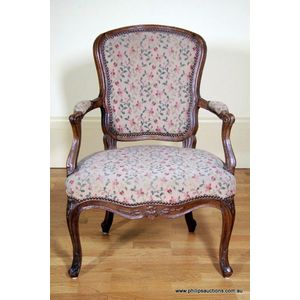Louis XIII Armchairs in Multicoloured Velvet Brocade
You must be a subscriber, and be logged in to view price and dealer details.
Subscribe Now to view actual auction price for this item
When you subscribe, you have the option of setting the currency in which to display prices to $Au, $US, $NZ or Stg.
- Turning - Any part of a piece of furniture that has been turned and shaped with chisels on a lathe. Turned sections include legs, columns, feet, finials, pedestals, stretchers, spindles etc. There have been many varieties and fashions over the centuries: baluster, melon, barley-sugar, bobbin, cotton-reel, rope-twist, and so on. Split turning implies a turned section that has been cut in half lengthwise and applied to a cabinet front as a false decorative support.
- Oak - Native to Europe and England, oak has been used for joinery, furniture and building since the beginning of the medieval civilisation. It is a pale yellow in colour when freshly cut and darkens with age to a mid brown colour.
Oak as a furniture timber was superceded by walnut in the 17th century, and in the 18th century by mahogany,
Semi-fossilised bog oak is black in colour, and is found in peat bogs where the trees have fallen and been preserved from decay by the bog. It is used for jewellery and small carved trinkets.
Pollard oak is taken from an oak that has been regularly pollarded, that is the upper branches have been removed at the top of the trunk, result that new branches would appear, and over time the top would become ball-like. . When harvested and sawn, the timber displays a continuous surface of knotty circles. The timber was scarce and expensive and was used in more expensive pieces of furniture in the Regency and Victorian periods. - Circa - A Latin term meaning 'about', often used in the antique trade to give an approximate date for the piece, usually considered to be five years on either side of the circa year. Thus, circa 1900 means the piece was made about 1900, probably between 1895 and 1905. The expression is sometimes abbreviated to c.1900.
This item has been included into following indexes:
Visually similar items

A set of three oak Louis XIII style chairs with footstool, circa 1950s, with high rectangular shaped backs and a stuffover seat, studded and upholstered in a green and rose tapestry style fabric, with curvaceous scroll end arms, the legs and 'H' form stret

A Louis XV-style walnut fauteuil, 19th century, possibly earlier, the moulded frame decorated with carved decorative details, upholstered in close-nailed floral fabric. Height 88 cm. Width 61 cm. Depth 64 cm.

A late 19th century walnut fauteuil with period tapestry upholstery on carved cabriole legs.

A pair of Louis XIV-style walnut fauteuils each with a high square back and open arms above the generous seat, on scrolling legs joined with an H-form stretcher, the arms and legs carved and moulded, upholstered in coloured floral jacquard. Height 117 cm.
